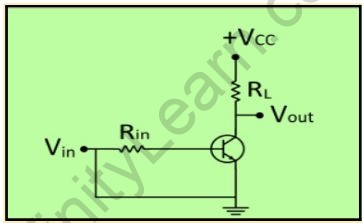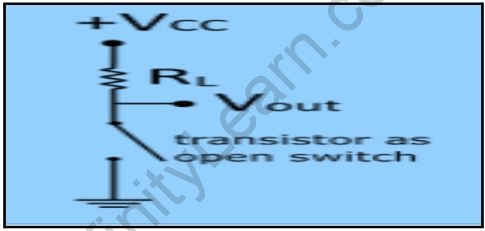Table of Contents
When used as an AC signal amplifier, the transistor’s base biassing voltage is applied in such a way that it always operates within its “active” region, i.e., the linear part of the output characteristic curves. However, by biassing the transistor’s Base terminal differently than for a signal amplifier, both NPN and PNP type bipolar transistors can be made to operate as “ON/OFF” type solid-state switches. Solid-state switches are one of the most common applications for using transistors to turn a DC output “ON” or “OFF.” Some output devices, such as LEDs, require only a few milliamps at logic level DC voltages and can thus be directly driven by the output of a logic gate. However, high-power devices such as motors, solenoids, or lamps frequently require more power than an ordinary logic gate can provide, so transistor switches are used.
If the circuit employs a bipolar transistor as a switch, the blessing of the transistor, either NPN or PNP, is configured to operate the transistor on both sides of the previously discussed ” I-V ” characteristics curves. The Saturation Region and the Cut-off Region are the areas of operation for a transistor switch. This means we can ignore the operating Q-point biasing and voltage divider circuitry required for amplification and simply drive the transistor back and forth between its “fully-OFF” (cut-off) and “fully-ON” (saturation) regions, as shown below.
Transistors are three-layer, three-terminal semiconductor devices that are commonly used in signal amplification and switching. The transistor, as one of the most important electronic devices, has found use in a wide range of applications, including embedded systems, digital circuits, and control systems. Transistors can be found in both the digital and analogue domains because they are widely used in a variety of applications such as switching circuits, amplifier circuits, power supply circuits, circuits such as digital logic, voltage regulators, and oscillator circuits are examples. This article focuses primarily on the switching action of the transistor and provides a brief overview of the transistor as a switch.
In this Transistor tutorial, we will learn how a Transistor works as a Switch. Transistors are used for switching and amplification, and the transistor as a switch serves as the foundation for many digital circuits. We will learn about the different operating modes of a transistor (Active, Saturation, and Cut-off), how a transistor works as a switch (both NPN and PNP), and some practical application circuits that use a transistor as a switch. A comprehensive guide to using a transistor as a switch.
Overview
The most basic application for a transistor is as a switch. A transistor is widely used for switching operations, such as opening or closing a circuit. Meanwhile, the fundamental concept underlying the operation of a transistor as a switch is dependent on its mode of operation. In this mode, transistors generally turn on or off the low voltage DC. PNP and NPN transistors can both be used as switches. By biassing both NPN and PNP bipolar transistors with an “ON / OFF” static switch, a basic terminal transistor can be handled differently than a signal amplifier. Solid-state switches are one of the most common applications of the transistor to convert a DC signal “on” or “off.”
Some devices, such as LEDs, only require a few milliamperes of DC voltage at the logical level and can be controlled directly via the logical gate output. High-power devices, such as generators, solenoids, or lamps, typically require more power than the typical logic gate to use transistor switches. As a solid-state switch, a transistor can be used. When the transistor is in the saturation region, it behaves like a closed switch, and when it is in the cut-off region, it behaves like an open switch. The transistor functions as a solid-state switch with a single pole and a single throw (SPST). When a zero input signal is applied to the transistor’s base, it acts as an open switch. When a positive signal is applied to the input terminal, it acts as a closed switch. When the transistor is used as a switch, the current through the transistor is zero and the voltage across it is maximum in the cut-off region, the current through the transistor is maximum, and the voltage across it is zero in the saturation region. As a result, the transistor switch has zero power loss in both the on and off states.

Transistor as an open switch
Working of transistor as a switch
A transistor’s operation is based on its operating regions. The base current will be zero in the cut-off region. Because the input is zero, the collector current will be zero as well if the voltage at the collector is kept at its maximum. This is true for N-P-N transistors, but for P-N-P transistors, the voltage at the emitter must be negative. Because there is no flow of carriers in this condition, the width of the region known as depletion expands, indicating that no current flow is present. The cut-off region is the name given to this type of region.
The next condition under which the switch is activated is saturation, in which the currents at the base and collector are maximized while the voltage at the collector is kept to a minimum. This operating condition causes the transistor to be fully ON. This is true for N-P-N transistors, but for P-N-P transistors, the emitter voltage must be kept positive in relation to the base voltage. This is referred to as a single pole single throw operation of the transistor (SPST). This means that if the signal applied to the base is zero, the transistor will be ON; otherwise, it will be OFF.
The switching operation is carried out after the voltage has been applied to the region of the base based on it. The cut-in voltage exists in the same way that the diode condition does. The applied voltage must reach the cut-in voltage between the emitter and base regions. If it crosses it, the transistor is said to be ON; otherwise, it is said to be OFF. When the transistor is turned on, the current generated tends to flow from the source to the load. The load can be either an LED or a resistor, depending on the application.
The operating conditions of the P-N-P and N-P-N transistors differ depending on whether they are applied with positive or negative voltages. However, the operation’s criteria remain the same. The flow of current is observed if it is in the ON position; otherwise, it is in the OFF position.
The load is connected to the transistor’s respective ground, and the transistor P-N-P then switches power. The terminal base is attached to the ground in this situation. For the P-N-P and N-P-N bipolar junction transistors, the above is the basic application of the transistor as a switch.
Transistor as a switch Applications
The transistor used as a switch has the following applications:
- The most common practical application for the transistor as a switch is the operation of an LED.
- The relay operation can be controlled by making the necessary changes to the circuit so that any external device can be connected to the relay and controlled.
- Using the transistor concept, dc motors can be controlled and monitored. This application is used to turn on and off the motor. The speed of the motor can be changed by varying the values of the transistor’s frequencies.
- A light-bulb is an example of one of these switches. It makes it easier to turn on the light in a bright environment and turn it off in a dark environment. It is accomplished by employing a light-dependent resistor (LDR).
- This switching technique can be used to monitor a component called a thermistor, which senses the surrounding temperature. A thermistor is also known as a resistor. When the sensed temperature is low, the resistance increases, and when the sensed temperature is high, the resistance decreases.
A transistor is a semiconductor device that is used to amplify or switch electronic signals and power. A thermionic valve, also known as a vacuum tube, is a device that controls electric current flow in a high vacuum between electrodes with an electric potential difference. Previously, thermionic valves were used, but transistors are now used instead because transistors have no cathode heater, which reduces power consumption, are small in size and weight, which reduces equipment size, and can be manufactured as a single integrated circuit. Transistors function as Thermionic valves.
Also read: Semiconductors
Frequently Asked Questions
Q. Is it possible to use a transistor as a switch?
Ans: Transistor switches can be used to control and switch lights, relays, and even motors. When used as a switch, the bipolar transistor must be either “fully-OFF” or “fully-ON.” Saturation refers to the state of a transistor when it is fully “ON.”
Q. Why is a transistor used as a switch?
Ans: If the transistor is biased in the saturation and cut-off regions, it can be used as a switch. This permits current to flow (or not flow) in other parts of a circuit. Because the collector current of a transistor is proportionally limited by its base current, it can be used as a current-controlled switch.






